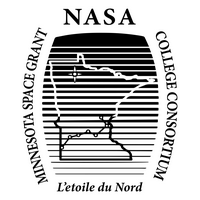Minnesota Space Grant Consortium
UMD Research

The MnSGC has supported neutrino research done the UMD particle astrophysics group for fourteen years. While NASA isnât involved in fundamental particle research, it does have a very active interest in cosmic ray physics. The UMD group uses high energy physics devices to study cosmic rays at higher energies than NASAâs own balloon-borne experiments, complementing those efforts. The groupâs NOvA efforts are aimed squarely at making sure neutrinos from nearby supernova are detected in time to provide early warning to traditional astronomers (as are the recent work on the HALO experiment, a small dedicated supernova neutrino experiment). The MINOS long-baseline neutrino experiment measured fundamental neutrino properties and is now dismantled; the MINERvA experiment studies the neutrino interactions themselves; and NOvA is in its 4th year of data taking. All three NuMI experiments have a large overlap in personnel, skills, tools, and research topics, with Dr. Habig concentrating on operations and cosmic ray analysis and NOvA data acquisition and supernovae; and Dr. Gran on MINOS and MINERvA neutrino interaction analyses. Space Grant has been instrumental in supporting UMD undergraduatesâ participation in these experiments. UMD has a strong undergraduate research emphasis, with Physics, Electrical Engineering, and Computer Science students having developed experimental hardware, software monitoring tools, simulations, and data analysis. The NSF is the primary source of UMDâs funding, but restricted NSF budgets have made Space Grant the main source of undergrad research stipends in our group. UMD students supported by Space Grant have spent substantial time onsite at the Soudan Mine Underground Lab, Fermilab, and the Super-Kamiokande experiment in Japan, working shoulder-to-shoulder with graduate students and postdocs from collaborating institutions from all over the world.
MnSGC funding will be used for ~1.5 student research assistants, with some travel funds for mileage to the experimental sites. These students really are doing front-line âBig Scienceâ in a way which undergraduates at larger institutions rarely get to participate in. As a result, many have taken this experience and the contacts gained from it and proceeded on to graduate school in related fields. Others have taken jobs in industry, universally in STEM fields. The summer of 2018 saw undergraduate Anna Heggesteun in residence at Fermilab helping to construct the NOvA Test Beam project, a mini NOvA placed in a known beam to help calibrate the larger detectors.

